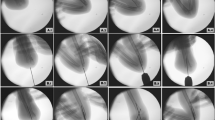Abstract
Introduction
Closed reduction and percutaneous pinning is a standard treatment for dislocated supracondylar humeral fractures in children. However, the management of these fractures remains challenging. The aim of this study was to evaluate lateral external fixation as a treatment alternative for these fractures.
Materials and methods
All supracondylar fractures treated with lateral external fixation between 2005 and 2007 were evaluated retrospectively. Long-term outcome was assessed with regards to carrying angle, malalignment, and motion.
Results
Twenty-eight patients with Gartland type III fractures and one with a Y-type fracture were included in the study (mean age 6.5 years). Cosmetic results were excellent in 88%, good in 8%, and fair in one patient. Functional results were excellent in 83%, good in 10%, and fair in 7%. However, 3 patients (10%) showed complete radial palsy postoperatively. In all of these patients, high insertion of the proximal pin (2.9–3.6 cm above the fracture) was noted. On revision, one superficial lesion and one total transection of the nerve at the level of the proximal pin was detected. One patient showed no macroscopic damage. The transected nerve was reconstructed using an autograft, and all patients completely recovered within 2–6 months.
Conclusion
Lateral external fixation is an alternative method for the treatment of displaced or unstable supracondylar fractures in children, facilitating reduction and improving fracture stability. However, iatrogenic radial nerve injury is a risk, and we therefore strongly recommend inserting the proximal pin under direct vision within 2 cm from the fracture line using a drill sleeve.


Similar content being viewed by others
References
Minkowitz B, Busch MT. Supracondylar humerus fractures. Current trends and controversies. Orthop Clin North Am. 1994;25:581–94.
Landin LA. Fracture patterns in children. Analysis of 8,682 fractures with special reference to incidence, etiology and secular changes in a Swedish urban population 1950–1979. Acta Orthop Scand Suppl. 1983;202:1–109.
Gartland JJ. Management of supracondylar fractures of the humerus in children. Surg Gynecol Obstet. 1959;109:145–54.
Gosens T, Bongers KJ. Neurovascular complications and functional outcome in displaced supracondylar fractures of the humerus in children. Injury. 2003;34:267–73.
Taller S. Use of external fixators in the treatment of supracondylar fractures of the humerus in children. Acta Chir Orthop Traumatol Cech. 1986;53:508–14.
Slongo T, Schmid T, Wilkins K, Joeris A. Lateral external fixation—a new surgical technique for displaced unreducible supracondylar humeral fractures in children. J Bone Joint Surg Am. 2008;90:1690–7.
Flynn JC, Matthews JG, Benoit RL. Blind pinning of displaced supracondylar fractures of the humerus in children. Sixteen years’ experience with long-term follow-up. J Bone Joint Surg Am. 1974;56:263–72.
Gordon JE, Patton CM, Luhmann SJ, Bassett GS, Schoenecker PL. Fracture stability after pinning of displaced supracondylar distal humerus fractures in children. J Pediatr Orthop. 2001;21:313–8.
Lee YH, Lee SK, Kim BS, et al. Three lateral divergent or parallel pin fixations for the treatment of displaced supracondylar humerus fractures in children. J Pediatr Orthop. 2008;28:417–22.
Brauer CA, Lee BM, Bae DS, Waters PM, Kocher MS. A systematic review of medial and lateral entry pinning versus lateral entry pinning for supracondylar fractures of the humerus. J Pediatr Orthop. 2007;27:181–6.
Prevot J, Lascombes P, Metaizeau JP, Blanquart D. Supracondylar fractures of the humerus in children: treatment by downward nailing. Rev Chir Orthop Reparatrice Appar Mot. 1990;76:191–7.
Weinberg AM, von Bismarck S, Castellani C, Mayr J. Descending intramedullary nailing for the treatment of displaced supracondylar humeral fractures in children. Der Chirurg; Zeitschrift für alle Gebiete der operativen Medizen. 2003;74:432–6.
Schaffer K, Bohm R, Dietz HG. Elastic stable intramedullary nailing (ESIN) of supracondylar fractures of the humerus in children. Der Unfallchirurg. 2007;110:852–8.
Gris M, Van Nieuwenhove O, Gehanne C, Quintin J, Burny F. Treatment of supracondylar humeral fractures in children using external fixation. Orthopedics. 2004;27:1146–50.
Noger M, Berli MC, Fasel JH, Hoffmeyer PJ. The risk of injury to neurovascular structures from distal locking screws of the Unreamed Humeral Nail (UHN): a cadaveric study. Injury. 2007;38:954–7.
Rupp RE, Chrissos MG, Ebraheim NA. The risk of neurovascular injury with distal locking screws of humeral intramedullary nails. Orthopedics. 1996;19:593–5.
Bono CM, Grossman MG, Hochwald N, Tornetta P, 3rd. Radial and axillary nerves. Anatomic considerations for humeral fixation. Clin Orthop Relat Res. 2000;373:259-64.
Carlan D, Pratt J, Patterson JM, Weiland AJ, Boyer MI, Gelberman RH. The radial nerve in the brachium: an anatomic study in human cadavers. J Hand Surg Am. 2007;32:1177–82.
Fleming P, Lenehan B, Sankar R, Folan-Curran J, Curtin W. One-third, two-thirds: relationship of the radial nerve to the lateral intermuscular septum in the arm. Clin Anat. 2004;17:26–9.
Mangat KS, Martin AG, Bache CE. The “pulseless pink” hand after supracondylar fracture of the humerus in children: the predictive value of nerve palsy. J Bone Joint Surg Br. 2009;91:1521–5.
Blakey CM, Biant LC, Birch R. Ischaemia and the pink, pulseless hand complicating supracondylar fractures of the humerus in childhood: long-term follow-up. J Bone Joint Surg Br. 2009;91:1487–92.
Conflict of interest
The authors declare that there is no actual or potential conflict of interest in relation to this article.
Author information
Authors and Affiliations
Corresponding author
Rights and permissions
About this article
Cite this article
Horst, M., Altermatt, S., Weber, D.M. et al. Pitfalls of lateral external fixation for supracondylar humeral fractures in children. Eur J Trauma Emerg Surg 37, 405–410 (2011). https://doi.org/10.1007/s00068-010-0062-5
Received:
Accepted:
Published:
Issue Date:
DOI: https://doi.org/10.1007/s00068-010-0062-5



